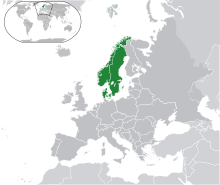Scandinavia
 |
|
| Area | 928,057 km2 (358,325 sq mi) |
|---|---|
| Population | ~27 million (2016) |
| Pop. density | 22/km2 (57/sq mi) |
| Demonym | Scandinavian |
| Countries |
Sometimes also: |
| Languages |
Minority or regional languages: |
| Time zones |
UTC+1 UTC+2 (DST) |
| Internet TLD | |
Minority or regional languages:
Scandinavia/ˌskændᵻˈneɪviə/ is a historical and cultural region in Northern Europe characterized by a common ethnocultural North Germanic heritage and mutually intelligible North Germanic languages.
The term Scandinavia always includes the three kingdoms of Denmark, Norway, and Sweden. The remote Norwegian islands of Svalbard and Jan Mayen are usually not seen as a part of Scandinavia, nor is Greenland, an overseas territory of Denmark. However, the Faroe Islands, also a Danish overseas territory, are sometimes included, as sometimes are Iceland and Finland, because of their historical association with the Scandinavian countries and the Scandinavian peoples and languages. This looser definition almost equates to that of the Nordic countries. In Nordic languages, only Denmark, Norway and Sweden are commonly included in the definition of Scandinavia.
In English usage, Scandinavia sometimes refers to the geographical area, also known as the Scandinavian Peninsula. The name Scandinavia originally referred vaguely to the formerly Danish, now Swedish, region Scania. The terms Scandinavia and Scandinavian entered usage in the late 18th century as terms for Denmark, Norway and Sweden, their Germanic majority peoples and associated language and culture, the term being introduced by the early linguistic and cultural Scandinavist movement.
...
Wikipedia
